What is a transistor?
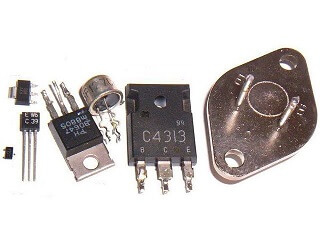
A transistor is a kind of semiconductor device that is short for transfer resistance regulates or controls the electrical signal like current or voltage. On 23 December 1947, it is developed by three American physicists William Shockley, Walter Brattain, and John Bardeen. Generally, it is a switching device or miniature device used to transfer a weak signal from a short resistance circuit to a high resistance circuit. It is a component that is made up of semiconductors. The below picture represents the example of a transistor.
In most electronic devices, the transistor is one of the key components, and it generates the binary bits 0’s and 1’s that are used by the computer to establish communication as well as deal with Boolean logic. In the history of science, one of the most important inventions is considered the transistor that forms logic gates when placed in different configurations. Those gates combine into full adders or into arrays known as half adders. Two PN diodes are included in the transistor, which is linked back to back.
A transistor consists of three terminals: input, output, and controlling switching. The name of the three terminals contained by the transistor is the emitter, base, and collector.
These terminal names are specified on the basis of the common terminal of the transistor. It is widely embedded into integrated circuits or found in circuit boards as discrete parts. For modern electronic devices, it is the important structure block. Doping, a chemical process used to create transistors, in which an extra positive charge (P-type) or extra negative charge (N-type) is gained by the semiconductive material. The PNP or NPN are two configurations for this, with middle material that function as the base or flow control. Through the whole component, a large amount of electricity flowing when a little change in the voltage or current in the middle base layer, which can be led to use as an amplifier.
Parts of the Transistor
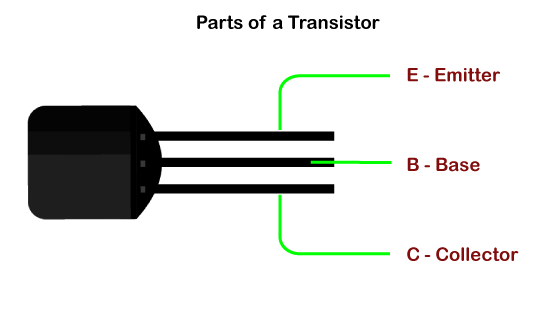
A transistor is made by more specifically terminals or three layers of semiconductor materials, which led to carry the current and establish a connection to an external circuit. With the help of other pairs of terminals, a current is controlled by the voltage. A transistor has three terminals, which are as follows:
- Base: The primary function of the base terminal is to activate the transistor, which design two circuits; the output circuit the collector and input with emitter. The thin layers are used to make it, which is the middle section of a transistor. The low resistance to the circuit is offered by the emitter-base circuit, which is forward biased. The higher resistance to the circuit is provided by the collector-base junction, which is located in opposite bias.
- Collector: It is the left part of the diode and the positive lead of the transistor. Removing the majority charges from the junction with the base is a primary function of the collector.
- Emitter: The emitter diode is the right part of the diode, which functions for the large sector of the majority trust carrier. It is the negative lead of the transistor that functions for the majority charge carrier to the base.
Transistor Symbols
The NPN transistor and PNP transistor are the two kinds of a transistor. Equally, the transistor that has two layers of P-type material and one layer of N-type material is called as a PNP transistor. The below picture is representing the symbol of NPN and PNP transistor. The arrow symbol describes the flow of emitter current with forward biasing, which is implemented to the emitter-base junction. The route of the current is the primary difference between the PNP and NPN transistors.

In the NPN connection, the conventional current flows out of the emitter, as specified with the help of the outgoing arrow in the figure. Similarly, in the PNP connection, the conventional current flows into the emitter; it can be seen in the figure, which has represented by the inward arrow.
Types of Transistors
Transistors are mainly two types on the basis of how they are used in a circuit, which are as follows:
Bipolar Junction Transistor (BJT)
Bipolar Junction Transistors are the kinds of transistors that comprise of terminals, base, emitter, and collector. It is considered a current-controlled device. A much larger current flow between the collector and emitter terminal can be controlled by a minor current entering the base region of the transistor. Moreover, BJT (Bipolar Junction Transistor) has other two major types, PNP transistor, and NPN transistor, which are discussed below:
- PNP Transistor: Another type of Bipolar Junction Transistors that has two p-type semiconductor materials where n-type material is introduced or placed between both. And a thin n-type semiconductor layer is used to divide these materials. Two crystal diodes connected in series are contained by the PNP transistor. Additionally, the device controls the flow of current in such a configuration. The left side of the diodes in this transistor is known as emitter-base diode, and the right side of the diodes is known as a collector-base diode.
In PNP transistors, electrons are the minority charge carriers, while holes are the majority charge carriers. The function of the arrow symbol in this transistor is to indicate the conventional current flow. In this transistor, the current flow path is from the emitter terminal to the collector terminal. There is given a picture below that represents the PNP transistor with a symbol. - NPN Transistor: One of other types of Bipolar Junction Transistors (BJT), which is widely used in the circuit and consists of a thin p-type semiconductor layer between two n-type materials. The main function of the NPN transistor is to increase weak signals to strong signals. In an NPN transistor, the current movements in the transistors when the electrons transfer from the emitter to the collector region. As compared to the mobility of holes, the electrons mobility is higher of NPN transistors; hence, they are commonly used at the present time. The below picture represents the NPN transistor with a symbol.
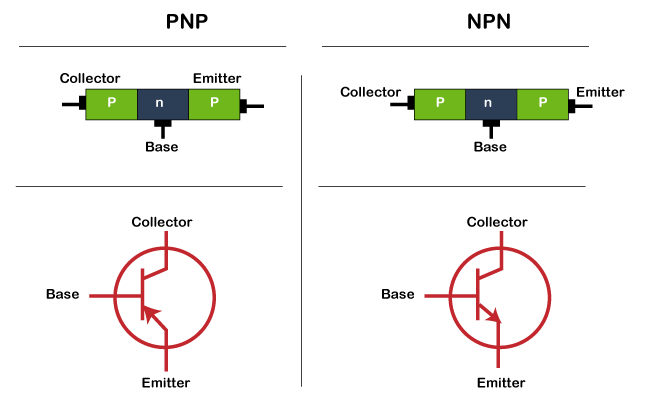
Field Effect Transistor
The three terminals, Gate, Source, and Drain, are used to make up Field Effect Transistors (FET). These kinds of transistors are considered voltage-controlled devices. The gate terminal controls the current between source and drain. The P channel FET or N channel FET in this transistor are used for conduction.
The value of the impedance of the circuit inversely affects the current, according to ohm’s law. That means the current is very low if the impedance is high. Thus, from a circuit’s power source, FETs draw very little current. The below image is of the Field Effect Transistor.
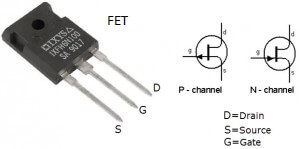
Therefore, the original circuit power elements that are connected to transistors are not disturbed by the transistors. As compared to bipolar transistors, FETs do not offer the high amplification that is the main limitation of FET.
FETs offer advantages, such as they cause less loading, easier to manufacture, and cheaper in cost. However, bipolar transistors are better in terms that they offer greater amplification. JFETs and MOSFETs are the main types of Field Effect Transistors (FET). Although MOSFETs and JFETs are very close to each other, MOSFETs have higher input impedance values as compared to JFETs. FET includes some features, which are discussed below:
- This transistor has high input impedance through which the input current will flow because of the reverse bias.
- In the FET, the charge carriers are responsible for the transmission of either electrons or holes, which causes it to make it unipolar.
- Sometimes, this transistor is named the voltage-controlled device; it happens when the input voltage of the gate controls the o/p voltage of the field-effect transistor.
- As compared to BJTs, FETs have less noise because there are no junctions present in the conduction lane.
- The characterization of gain is the ratio of input voltage change and o/p change current; therefore, it can be done with transconductance.
Some difference between FET and BJT
- The BJT is a bipolar device, whereas FET is a unipolar device.
- The BJT is a current-driven device, while FET is a voltage-driven device.
- As compared to BJTs, FETs have less noise.
- The thermal stability of FET is high while BJT has low.
- The gain characterization of BJT can be done through a voltage gain, whereas in FET with a transconductance.
Working of Transistor
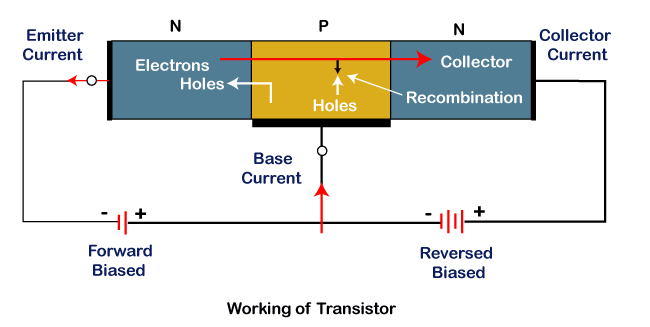
Usually, transistors are made of silicon as it has greater current, high voltage rating, and less temperature sensitivity. The base current is established by the emitter-base section kept in forward biased, which moves via the base region. The base current has a very small magnitude. The base current is responsible to make a hole in the base region or electrons to transfer into the collector region.
As compared to the emitter, transistors have a smaller number of electrons as the base of the transistor is lightly doped and very thin. The emitter’s few electrons are moved towards the collector region. Therefore, it can be said that by varying the base region, the large collector current is obtained.
Transistor history
The crucial component of an electronic device is a transistor that controls the electrical signal like current or voltage. Although a vacuum tube was developed by eccentric American inventor Lee De Forest in 1906, it used a lot of electrical power, and it was bulky in size. Also, the transistor was an appropriate solution to work with electronics as it uses much less power and small in size as compared to vacuum tubes.
During the war, the team had made radar possible by using some of the advances in semiconductor research.
On 23 December 1947, the transistor was developed by three American physicists William Shockley, Walter Brattain, and John Bardeen, and successfully demonstrated at Bell Laboratories in Murray Hill, New Jersey. However, as compared to the two others, William Shockley played an important or much different role in the development process of the transistor. For more than ten years, Shockley had been working on this type of project. Although he had the ability to work out the theory successfully, he could be unable to construct a working model after practicing for eight years.
To handle the engineering and development, Bardeen and Brattain were called. And they created the “point-contact” transistor. But the bipolar transistor was designed by Shockley that replaced the point-contact” transistor, and it was superior to it. Therefore, Shockley had a large part in the invention of the transistor. William Shockley went to work for Bell Labs as he completed his doctorate, specializing in quantum physics. In 1936, he had begun working on the basis for the transistor, the solid-state physics theory. A fine wire was included in signal detectors contained by early radios, which impinged on a galena crystal. This fine wire was known as a cat’s whisker. However, these early radios were unable to work successively. But it was the basis for the “point-contact” transistor, the principle on which the crystal detector worked.
In the first transistor, rather than galena, Brattain and Bardeen used germanium. However, they used similar cat whiskers. The bipolar transistor designed by Shockley eliminated the troublesome point contacts
In 1954, the commercial production of junction transistors for portable radios begun for the first time by the Texas Instruments of Dallas. In the same year,1954, there was an announcement by IBM that it was planning to replace vacuum tubes with transistors from its computers and introduced its first computer that had 2000 transistors. The production of transistors was also started by the Sony Company of Japan that dominated the market. Instead of vacuum tubes, Sony started to produce television sets with the help of using transistors in the 1960s. And, transistors replaced vacuum tubes, and almost vacuum tube technology became obsolete. As of 2016, more than seven billion transistors can be included by the most powerful computer processor.
Advantages and Disadvantages of the transistors
The below table contains the benefits and drawbacks of a transistor.
| ADVANTAGES | DISADVANTAGES |
|---|---|
|
|
